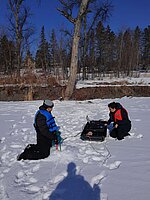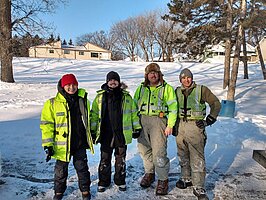Flood and Bathymetry Alteration Simulations Under Ice-Coverage in Red River

Berkay Koyuncu is a Ph.D. student in Environmental & Conservation Science at North Dakota State University (NDSU). He holds a Master of Science degree in Sustainable Environment and Energy Systems from Middle East Technical University (METU) and a Bachelor of Science degree in Environmental Engineering from Kocaeli University, Turkey. His current research is focused on understanding the impacts of secondary flow structures on the sediment transport and shear stress profile under ice-coverage conditions in natural streams. The main purpose of his work is to develop a model to explain the short-term/long-term morphology alteration in channel beds and possible consequences on Spring floods.
Flood and Bathymetry Alteration Simulations Under Ice-Coverage in Red River
The Impact of the Secondary Flow Structures on Shear Stress and Sediment Transport Under Open and Ice-coverage Conditions
Related to the climate change, the total coverage of river ice has declined globally, and new river dynamics might cause to unalike morphologic transformation of channel beds in cold regions, especially during the meltdown. The impact of ice layer on flow structures is still not well-known, even though it has drawn attention recently from various perspectives (e.g. hydrological, morphological).
Turbulent statistics and flow characteristics are monitored to scrutinize the fluctuations of hydrodynamic features under the ice layer. In this study, changes on the high velocity core distribution related to the morphological conditions of the river bed will be elucidated in field scale. Many previous researches, especially for ice-coverage case, are conducted in laboratory environment without a validation against the field scale study. The main objective of this study is to clarify unknown fundamentals of natural streams under ice layer by performing high Reynolds number cases with computational methods, and validating them against the field measurements.
Project Objectives:
The major objectives in this study are:
- define the behavior of primary and secondary flow structures in sharp bends under both open surface and ice-coverage conditions,
- identify the impact of flow structures on shear stress profiles, and
- reveal the effect of ice-layer on sediment transport.
Progress:
Field Measurements
Monitoring the flow characteristics in nature is a challenging process due to the many environmental difficulties, such as access issues, extreme weather conditions, and strong currents. A portion of Red River near Lindenwood Park, Fargo, was selected as the study field in this research, and many reasons played significant role on this preference. Process expediting man-made structures (i.e. dock and bridge) and existence of diuturnal ice layer are the main factors behind this selection, addition to the advantage of easy access throughout the year. Acoustic Doppler Current Profiler (ADCP) is used to measure the velocity components and river morphology in both Winter and Fall seasons. Generally, two main techniques were used to collect the data: (1) stationary measurement for both seasons, (2) moving boat for Fall seasons. While moving boat technique is aiming to collect bathymetry and cross-sectional data, stationary technique collects vertical profile of a certain location. Field measurements are carried out between Aug/2019 to Feb/2021.
Three-dimensional Model of the Study Field
Following the field surveys, creation of Digital Terrain Model (DTM) of the river bed plus the surrounding area was the next step in this research. LiDAR data of the entire Fargo was obtained from North Dakota Water Commission, and the study field was extracted. Collected river bathymetry during the field expeditions is merged with LiDAR data because the technology of LiDAR is constrained within the land area. Inverse-distance interpolation is then performed to more than 3 million data points into a rectangular zone with approximately 2 km2 area. This process is repeated following every measurement in Fall, in order to increase the reliability of the river morphology.
Large-eddy Simulation (LES)
The in-house code (Virtual Flow Simulator) is employed to simulate the turbulent flow in the study area. Multi-physics / multi-phase flows are able to be simulated by the code with advanced turbulence models (LES) over complex topographies. This model is comprehensively validated by the laboratory experiments previously. Various flow rates under open surface and ice-coverage conditions are simulated by using the HPC. During the simulations, computational resources are used from The Center for Computationally Assisted Science and Technology (CCAST) of NDSU and Bridges of Pittsburgh Supercomputing Center (PSC).
Conference/Seminar Presentations:
Koyuncu, B., and Akintug, B. 2019. Trend Analysis of Evapotranspiration in Northern Cyprus. To be presented at the 2019 European Geosciences Union (EGU) General Assembly, 7-12 April, Vienna, Austria.
Koyuncu, B., and Le, T. 2020. Secondary Flow Structures in Natural Channels Under Open and Ice Coverage Condition. To be presented at the 2020 Division of Fluid Dynamics (DFD) of American Physical Society, November 22-24.
Koyuncu, B., and Le, T. 2020. Structures of Icy Flows in River Bends. To be presented at the 2020 American Geosciences Union (AGU), December 7-11.
Koyuncu, B., and Le, T. 2020. Large-eddy Simulation Under Ice Coverage. To be presented at the 2021 ESIP Winter Meeting, January 26-29.



Dr. Trung B. Le
Civil and Environmental Engineering
Office: CIE201L
Telephone: 701-231-6369
Email: trung.le@ndsu.edu


